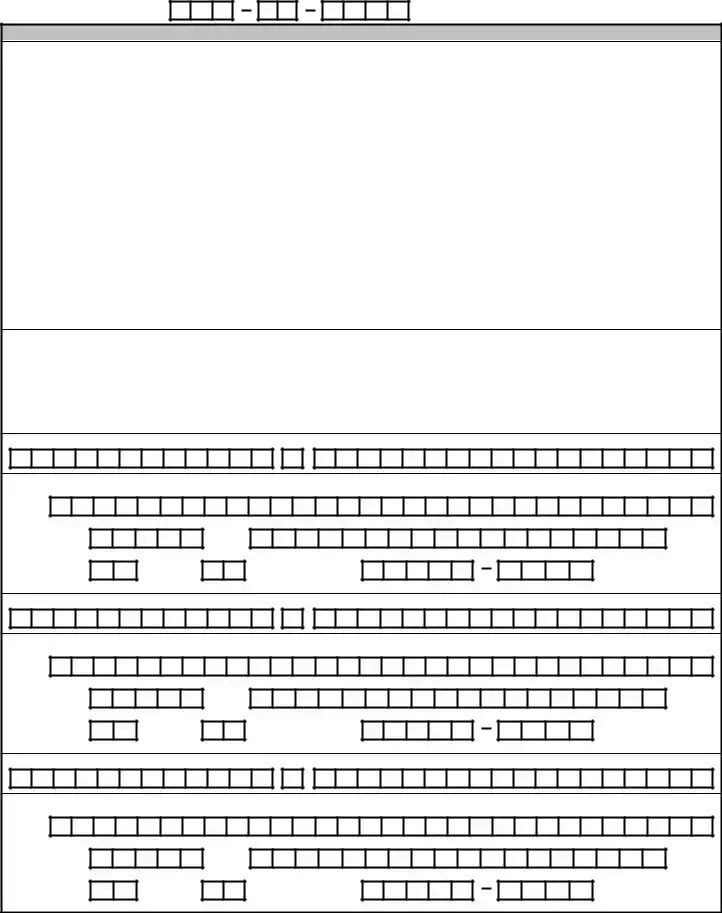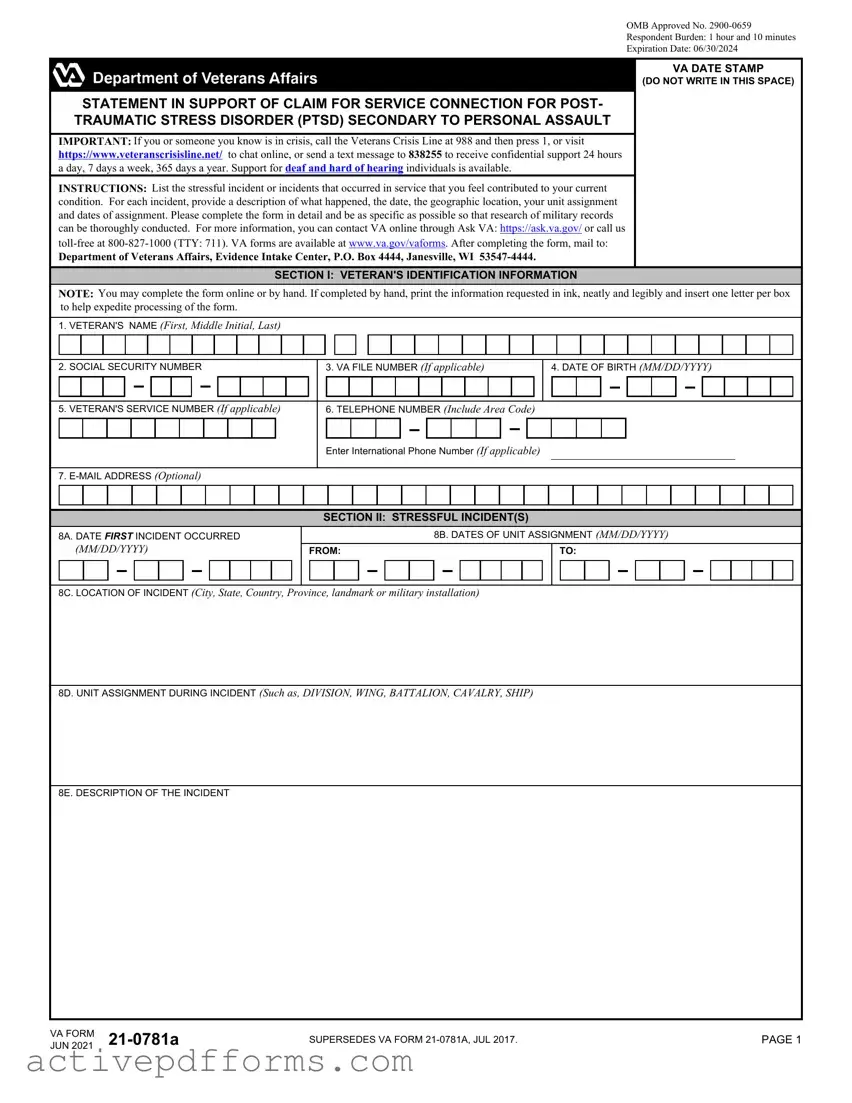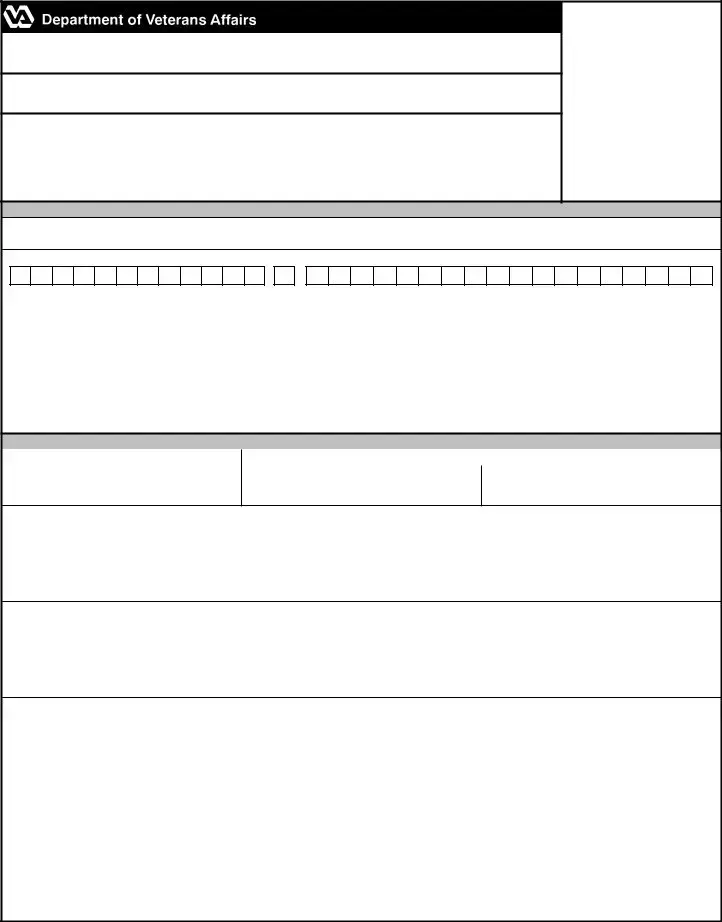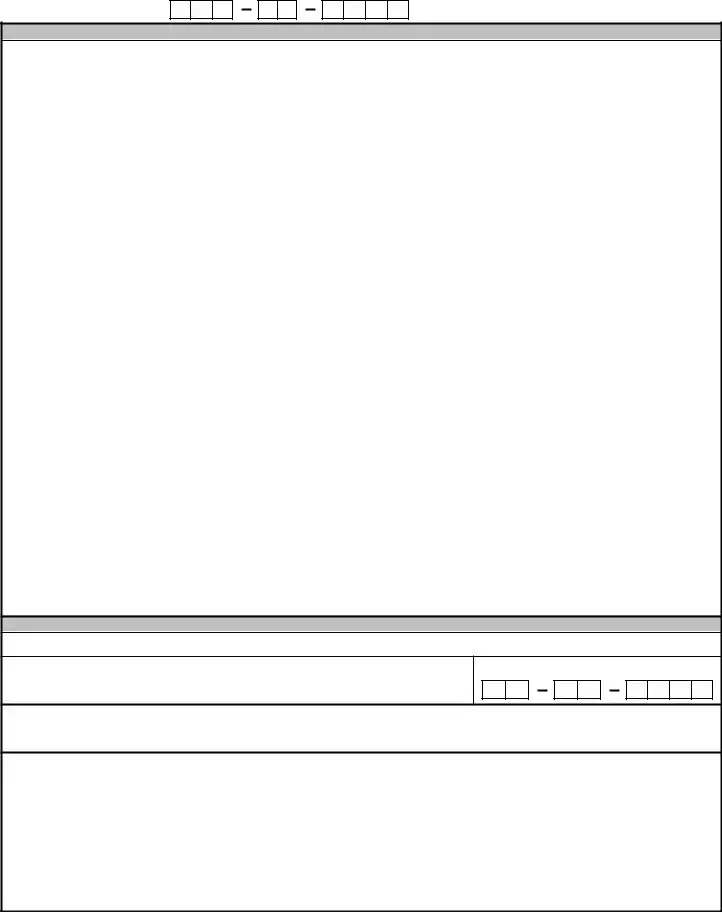OMB Approved No. 2900-0659 Respondent Burden: 1 hour and 10 minutes Expiration Date: 06/30/2024
STATEMENT IN SUPPORT OF CLAIM FOR SERVICE CONNECTION FOR POST- TRAUMATIC STRESS DISORDER (PTSD) SECONDARY TO PERSONAL ASSAULT
IMPORTANT: If you or someone you know is in crisis, call the Veterans Crisis Line at 988 and then press 1, or visit https://www.veteranscrisisline.net/ to chat online, or send a text message to 838255 to receive confidential support 24 hours a day, 7 days a week, 365 days a year. Support for deaf and hard of hearing individuals is available.
INSTRUCTIONS: List the stressful incident or incidents that occurred in service that you feel contributed to your current condition. For each incident, provide a description of what happened, the date, the geographic location, your unit assignment and dates of assignment. Please complete the form in detail and be as specific as possible so that research of military records can be thoroughly conducted. For more information, you can contact VA online through Ask VA: https://ask.va.gov/ or call us toll-free at 800-827-1000 (TTY: 711). VA forms are available at www.va.gov/vaforms. After completing the form, mail to:
Department of Veterans Affairs, Evidence Intake Center, P.O. Box 4444, Janesville, WI 53547-4444.
SECTION I: VETERAN'S IDENTIFICATION INFORMATION
VA DATE STAMP
(DO NOT WRITE IN THIS SPACE)
NOTE: You may complete the form online or by hand. If completed by hand, print the information requested in ink, neatly and legibly and insert one letter per box to help expedite processing of the form.
1.VETERAN'S NAME (First, Middle Initial, Last)
|
2. SOCIAL SECURITY NUMBER |
3. VA FILE NUMBER (If applicable) |
|
|
4. DATE OF BIRTH (MM/DD/YYYY) |
|
|
|
|
|
|
|
|
|
|
|
|
|
|
|
|
|
|
|
|
|
|
|
|
|
|
|
|
|
|
|
|
|
|
|
|
|
|
|
|
|
|
|
|
|
|
|
|
|
|
|
|
|
|
|
|
|
|
|
|
|
|
|
|
|
|
|
|
|
|
|
|
|
|
|
|
|
|
|
|
|
|
|
|
|
|
|
|
|
|
|
|
|
|
|
|
|
|
|
|
|
|
|
|
|
|
|
|
|
|
|
|
|
|
|
|
|
|
|
|
|
|
|
|
|
|
|
|
|
|
|
|
|
|
|
|
|
|
|
|
|
|
|
|
|
|
|
|
|
|
|
|
|
|
|
|
|
|
|
|
|
|
|
|
|
|
|
|
|
|
|
|
|
|
|
|
|
|
|
|
|
|
|
|
|
|
|
|
|
|
|
|
|
|
|
|
|
|
|
|
|
|
|
|
|
|
|
|
|
|
|
|
|
|
|
|
|
|
|
|
|
|
|
|
5. VETERAN'S SERVICE NUMBER (If applicable) |
6. TELEPHONE NUMBER (Include Area Code) |
|
|
|
|
|
|
|
|
|
|
|
|
|
|
|
|
|
|
|
|
|
|
|
|
|
|
|
|
|
|
|
|
|
|
|
|
|
|
|
|
|
|
|
|
|
|
|
|
|
|
|
|
|
|
|
|
|
|
|
|
|
|
|
|
|
|
|
|
|
|
|
|
|
|
|
|
|
|
|
|
|
|
|
|
|
|
|
|
|
|
|
|
|
|
|
|
|
|
|
|
|
|
|
|
|
|
|
|
|
|
|
|
|
|
|
|
|
|
|
|
|
|
|
|
|
|
|
|
|
|
|
|
|
|
|
|
|
|
|
|
|
|
|
|
|
|
|
|
|
|
|
|
|
|
|
|
|
|
|
|
|
|
|
|
|
|
|
|
|
|
|
|
|
|
|
|
|
|
|
|
|
|
|
|
|
|
|
|
|
Enter International Phone Number (If applicable) |
|
|
|
|
|
|
|
|
|
|
|
|
|
|
|
|
|
|
|
|
|
|
|
|
|
|
|
|
|
|
|
|
|
|
|
|
|
|
|
|
|
|
|
|
|
|
|
|
|
|
|
|
|
|
|
|
|
|
|
|
|
|
|
|
|
|
|
|
|
|
|
|
|
|
|
|
|
|
|
|
|
|
|
|
|
|
|
|
|
|
|
|
|
|
|
|
|
|
|
|
|
|
|
|
|
|
|
|
|
|
|
|
|
|
|
|
|
|
|
|
|
|
|
|
|
|
|
|
|
|
|
|
|
|
|
|
|
|
|
|
|
|
|
|
|
|
|
|
|
|
|
|
|
|
|
|
|
|
|
|
|
|
|
|
|
|
|
|
|
|
7. E-MAIL ADDRESS (Optional) |
|
|
|
|
|
|
|
|
|
|
|
|
|
|
|
|
|
|
|
|
|
|
|
|
|
|
|
|
|
|
|
|
|
|
|
|
|
|
|
|
|
|
|
|
|
|
|
|
|
|
|
|
|
|
|
|
|
|
|
|
|
|
|
|
|
|
|
|
|
|
|
|
|
|
|
|
|
|
|
|
|
|
|
|
|
|
|
|
|
|
|
|
|
|
|
|
|
|
|
|
|
|
|
|
|
|
|
|
|
|
|
|
|
|
|
|
|
|
|
|
|
SECTION II: STRESSFUL INCIDENT(S)
8A. DATE FIRST INCIDENT OCCURRED |
|
|
|
|
|
|
|
|
8B. DATES OF UNIT ASSIGNMENT (MM/DD/YYYY) |
|
|
(MM/DD/YYYY) |
FROM: |
|
|
|
|
|
|
|
|
|
|
|
|
TO: |
|
|
|
|
|
|
|
|
|
|
|
|
|
|
|
|
|
|
|
|
|
|
|
|
|
|
|
|
|
|
|
|
|
|
|
|
|
|
|
|
|
|
|
|
|
|
|
|
|
|
|
|
|
|
|
|
|
|
|
|
|
|
|
|
|
|
|
|
|
|
|
|
|
|
|
|
|
|
|
|
|
|
|
|
|
|
|
|
|
|
|
|
|
|
|
|
|
|
|
|
|
|
|
|
|
|
|
|
|
|
|
|
|
|
|
|
|
|
|
|
|
|
|
|
|
|
|
|
|
|
|
|
|
|
|
|
|
|
|
|
|
|
|
|
8C. LOCATION OF INCIDENT (City, State, Country, Province, landmark or military installation)
8D. UNIT ASSIGNMENT DURING INCIDENT (Such as, DIVISION, WING, BATTALION, CAVALRY, SHIP)
8E. DESCRIPTION OF THE INCIDENT
VA FORM |
21-0781a |
SUPERSEDES VA FORM 21-0781A, JUL 2017. |
PAGE 1 |
JUN 2021 |

VETERAN'S SOCIAL SECURITY NO.
SECTION II: STRESSFUL INCIDENT(S) (Continued)
8E. DESCRIPTION OF INCIDENT (Continued)
9.OTHER SOURCES OF INFORMATION: Identify any other sources (military or non-military) that may provide information concerning the incident in Items 9A through 9F. If you reported the incident to military or civilian authorities or sought help from a rape crisis center, counseling facility, or health clinic, etc., please provide the names and addresses and we will assist you in getting the information. If the source provided treatment and you would like us to obtain the treatment records, complete and sign VA Form 21-4142, Authorization and Consent to Release Information to the Department of Veterans Affairs (VA) and VA Form 21-4142a, General Release for Medical Provider Information to the Department of Veterans Affairs (VA), and fill in each provider. If you confided in roommates, family members, chaplains, clergy, or fellow service persons, you may want to ask them for a statement concerning their knowledge of the incident. Use VA Form 21-10210, Lay/Witness Statement, to provide these statements to the VA. These statements will help us in deciding your claim. Other sources of information also include personal diaries or journals. VA forms are available at www.va.gov/vaforms.
9A. NAME (First, Middle Initial, Last)
9B. MAILING ADDRESS (Number and street or rural route, P. O. Box, City, State, ZIP Code and Country)
No. &
Street
Apt./Unit Number
9C. NAME (First, Middle Initial, Last)
9D. MAILING ADDRESS (Number and street or rural route, P. O. Box, City, State, ZIP Code and Country)
No. &
Street
Apt./Unit Number
9E. NAME (First, Middle Initial, Last)
9F. MAILING ADDRESS (Number and street or rural route, P. O. Box, City, State, ZIP Code and Country)
No. &
Street
Apt./Unit Number
VA FORM 21-0781a, JUN 2021 |
PAGE 2 |
VETERAN'S SOCIAL SECURITY NO.
SECTION II: STRESSFUL INCIDENT(S) (Continued)
10.Please provide in the space below any other information that you feel is important for us to know that may help your claim. The following are some examples of behavioral changes that you may have experienced following the incident(s):
•visits to a medical or counseling clinic or dispensary without a specific diagnosis or specific ailment
•sudden requests for a change in occupational series or duty assignment
•increased use of leave without an apparent reason
•changes in performance and performance evaluations
•episodes of depression, panic attacks, or anxiety without an identifiable cause
•increased or decreased use of prescription medications
•increased use of over-the-counter medications
•substance abuse such as alcohol or drugs
•increased disregard for military or civilian authority
•obsessive behavior such as overeating or under eating
•pregnancy tests around the time of the incident
•tests for HIV or sexually transmitted diseases
•unexplained economic or social behavior changes
•breakup of a primary relationship
SECTION III: CERTIFICATION AND SIGNATURE
I HEREBY CERTIFY THAT the foregoing statement(s) are true and correct to the best of my knowledge and belief.
11. VETERAN'S SIGNATURE (REQUIRED)
12.DATE SIGNED (MM/DD/YYYY)
PENALTY: The law provides severe penalties which include fine or imprisonment or both, for the willful submission of any statement or evidence of a material fact, knowing it is false, or fraudulent acceptance of any payment to which you are not entitled.
PRIVACY ACT INFORMATION: The VA will not disclose information collected on this form to any source other than what has been authorized under the Privacy Act of 1974 or Title 38, Code of Federal Regulations 1.576 for routine uses (i.e., civil or criminal law enforcement, congressional communications, epidemiological or research studies, the collection of money owed to the United States, litigation in which the United States is a party or has an interest, the administration of VA programs and delivery of VA benefits, verification of identity and status, and personnel administration) as identified in VA system of records, 58VA21/22/28, Compensation, Pension, Education and Veteran Readiness and Employment Records - VA, published in the Federal Register. Your obligation to respond is voluntary. However, the requested information is necessary to obtain supporting evidence of stressful incidents in service. If the information is not furnished completely or accurately, VA will not be able to thoroughly research your military records and other sources for supporting evidence. The responses you submit are considered confidential (38 U.S.C. 5701).
RESPONDENT BURDEN: We need this information in order to assist you in supporting your claim for post-traumatic stress disorder (38 U.S.C. 5107 (a)). Title 38, United States Code, allows us to ask for this information. We estimate that you will need an average of 1 hour and 10 minutes to review the instructions, find the information, and complete this form. VA cannot conduct or sponsor a collection of information unless a valid OMB control number is displayed. You are not required to respond to a collection of information if this number is not displayed. Valid OMB control numbers can be located on the OMB Internet Page at www.reginfo.gov/public/do/PRAMain. If desired, you can call 1-800-827-1000 to get information on where to send comments or suggestions about this form.
VA FORM 21-0781a, JUN 2021 |
PAGE 3 |



